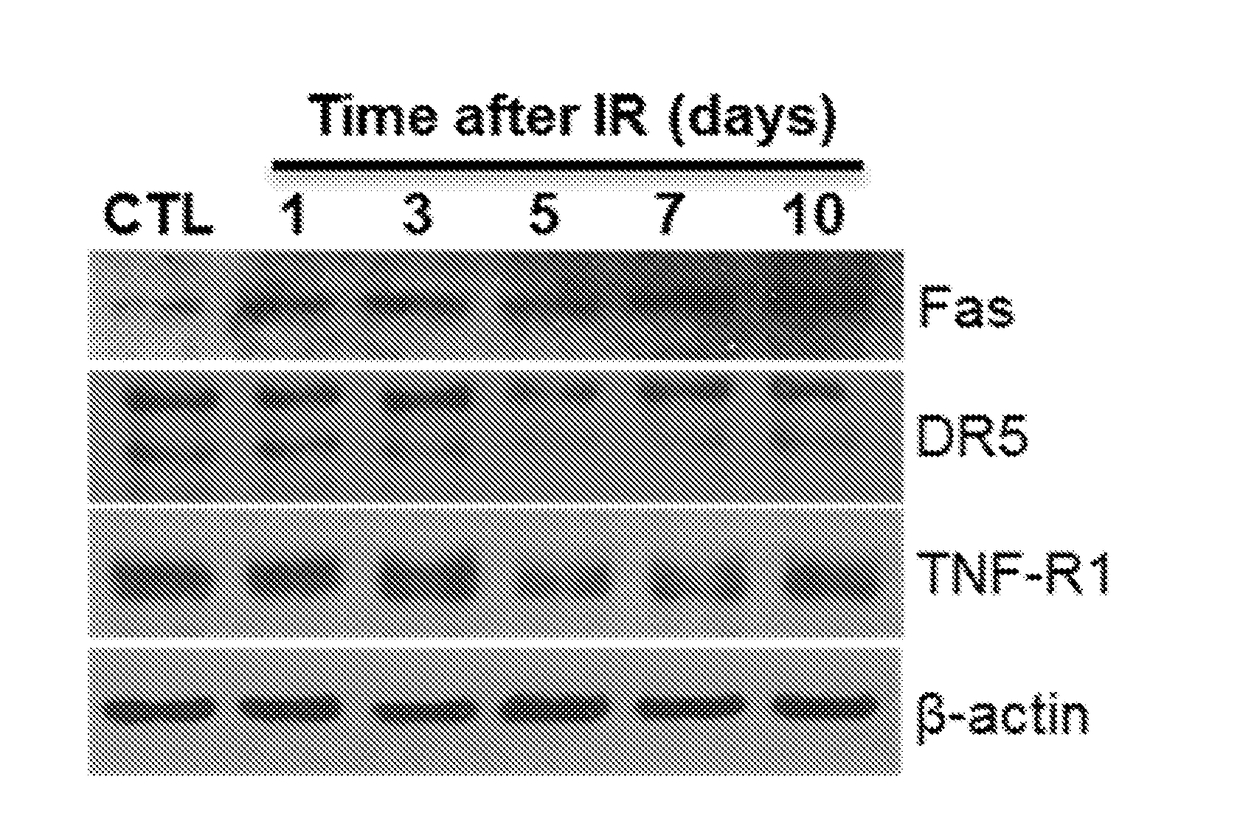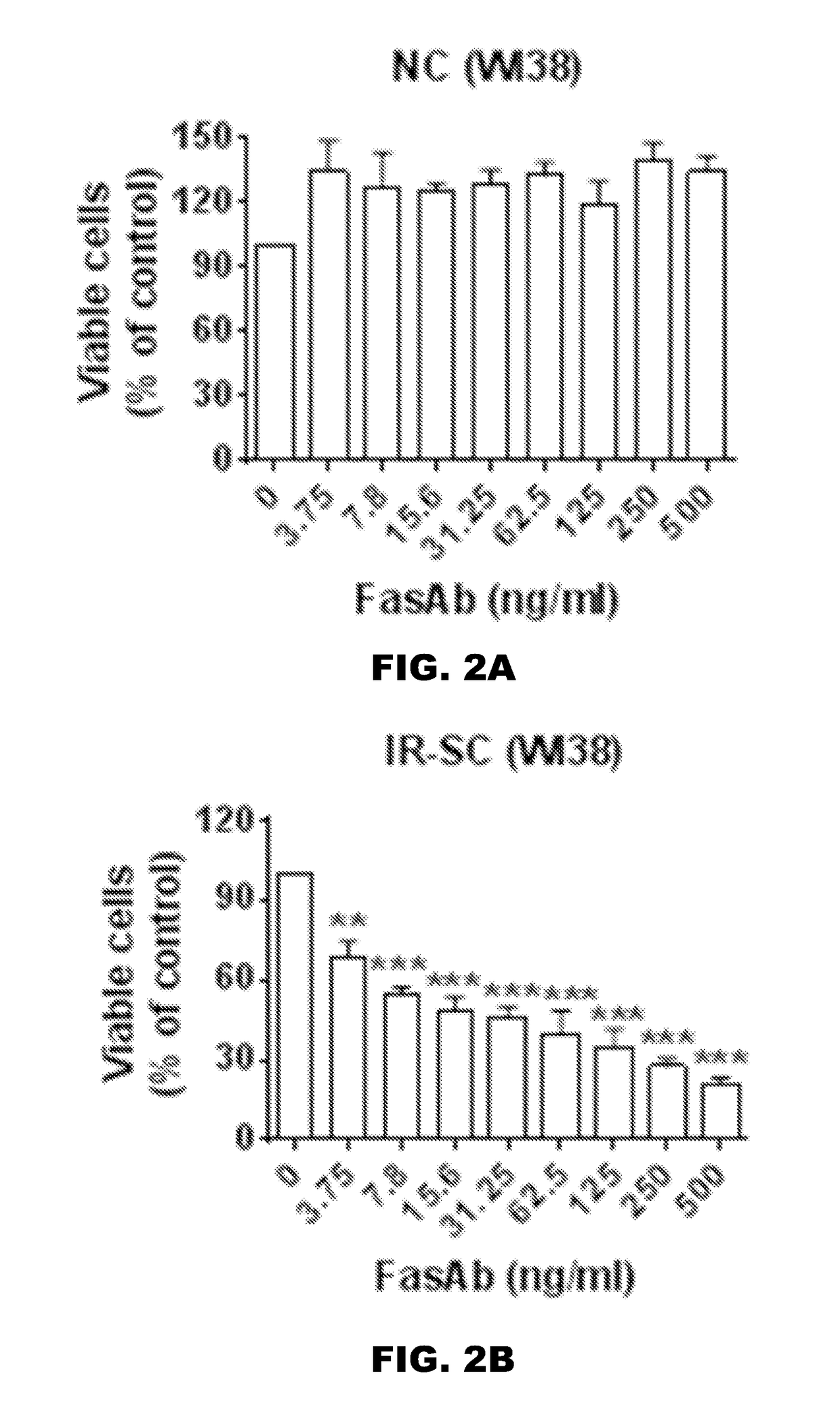FAS AND DRs ARE NOVEL MOLECULAR TARGETS OF SENESCENT CELLS
- Summary
- Abstract
- Description
- Claims
- Application Information
AI Technical Summary
Benefits of technology
Problems solved by technology
Method used
Image
Examples
example 1
Senescent Cells Express Increased Levels of Fas and DR5
[0123]Expression of Fas, death receptor 5 (DR5), tumor necrosis factor receptor 1 (TNF-R1) and β-actin was analyzed by Western blots in control (CTL) and WI38 human fibroblast cells 1, 3, 5, 7 and 10 days after exposure to 10 Gy γ-irradiation (FIG. 1A). Expression of Fas, DR5, TNF-R1 and β-actin was analyzed by Western blots in control (CTL) and replicative senescent (>40 passages) WI38 human fibroblast cells (FIG. 1B). The results showed that both IR-induced and replicative senescent cells (SC) expressed increased levels of Fas and DR5 but not TNF-R1 as compared with control cells.
example 2
FasAb and TRAIL Selectively Kill Senescent Cells by Induction of Apoptosis
[0124]Non-senescent cells (NC) and senescent WI-38 cells induced by IR (IR-SC) were incubated with different concentrations of FasAb (Clone CH11, Cat #05-201, Millipore, Mass., USA) or TRAIL (Cat #310-04, Peprotech, N.J., USA) for 3 days to count number of viable cells. Incubation of IR-SC cells with FasAb significantly reduced the number of viable cells relative to NC (FIG. 2B vs. FIG. 2A). Further, incubation of IR-SC cells with TRAIL significantly reduced the number of viable cells relative to NC (FIG. 2D vs. FIG. 2C).
[0125]WI-38 NC and IR-SC were incubated with vehicle (Veh), FasAb (10 ng / ml) or TRAIL (12.5 ng / ml) for 3 days, and apoptosis in these cells was determined by Annexin V-FITC staining and flow cytometry. Apoptosis was significantly increased in senescent cells treated with FasAb and TRAIL relative to untreated or non-senescent cells (FIG. 2E, FIG. 2F).
[0126]NCs and IR-SCs were incubated with veh...
example 3
FasAb and TRAIL Synergistically Kill IR-Induced Senescent Cells with ABT263
[0129]Non-senescent cells (NC) and senescent WI-38 cells induced by IR (IR-SC) were incubated with ABT263 (ABT, 1.25 μm), FasAb (10 ng / ml) and / or TRAIL (12.5 ng / ml) for 3 days to count number of viable cells. The combination of ABT (a Bcl-2 inhibitor) and FasAb or TRAIL further enhanced the reduction in viable cells when incubated with senescent cells (FIG. 3B, FIG. 3D). There was no effect on non-senescent cells (FIG. 3A, FIG. 3C).
[0130]Non-senescent cells (NCs) and senescent IMR90 cells induced by IR (IR-SC) were incubated with ABT163 (ABT, 1.25 μm), FasAb (10 ng / ml) and / or TRAIL (12.5 ng / ml) for 3 days to count number of viable cells. As with the WI-38 cells, the combination of ABT (a Bcl-2 inhibitor) and FasAb or TRAIL further enhanced the reduction in viable cells when incubated with senescent cells (FIG. 3F, FIG. 3H). There was no effect on non-senescent cells (FIG. 3E, FIG. 3G).
PUM
| Property | Measurement | Unit |
|---|---|---|
| Fraction | aaaaa | aaaaa |
| Reduction potential | aaaaa | aaaaa |
Abstract
Description
Claims
Application Information
 Login to View More
Login to View More - R&D
- Intellectual Property
- Life Sciences
- Materials
- Tech Scout
- Unparalleled Data Quality
- Higher Quality Content
- 60% Fewer Hallucinations
Browse by: Latest US Patents, China's latest patents, Technical Efficacy Thesaurus, Application Domain, Technology Topic, Popular Technical Reports.
© 2025 PatSnap. All rights reserved.Legal|Privacy policy|Modern Slavery Act Transparency Statement|Sitemap|About US| Contact US: help@patsnap.com



